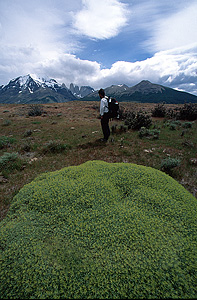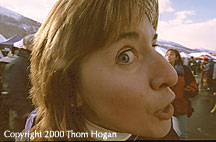Autofocus
Sigma 14mm f/3.5 Zen |
||||||||||||||
| A seriously wide angle of view that's difficult to master, but fun to use.
The BasicsSigma has been making high quality, unusual optics for some time. One of my earliest non-Nikon purchases was the 14mm f/3.5 (now replaced in Sigma's lineup by an almost identical lens that has a larger maximum aperture of f/2.8). If you've never sighted through the viewfinder with a lens this wide, you're in for a real treat (or surprise).
The focus ring is narrow, but easily distinguished by its knurled rubber pattern. You can't really use filters with this lens, though there is a small "slot" at the rear that can be used to slip in thin gelatin filters cut to size. At over a pound (1 pound 2 ounces), you'll be amazed by the heft (it's a small lens, just heavy).
HandlingI really doubt you'll be manually focusing this beast--you get almost no benefit from doing so due to the huge depth of field--but if you do, you'll find the action a little loose and finicky. Autofocus on my N90s, F100, F5, and D1x is quite fast, almost amazingly so. I've never seen the lens hunt on autofocus. But...the focusing is a louder than the Nikkor 20mm f/2.8--this is not a lens to use in quiet situations. The aperture ring is fine, with solid click stops. The front element is very significantly exposed, so you're going to get fingerprints on this beauty if you aren't careful. The supplied "lens cap" is one of the more unusual I've seen--it actually has a cap on the cap! You really have to see it to understand.
PerformanceWith one major caveat, the Sigma 14mm f/3.5 is a decent performer. The edges are a little soft wide open. And I wouldn't use the lens at f/22, as defraction seems to take a bit of sharpness away at minimum aperture. Fortunately, depth of field is so great even at f/3.5 (hyperfocal distance is less than 8'), that you'll never really need to stop all the way down. I expected more light falloff in the corners, but this common wide-angle problem is well controlled on this lens. Unbelievably, straight lines really do stay straight.
|
| Quick Evaluation |
Last
update: July 23, 2003 |
| Table of Contents |
| Others Ask |
jsw
writes: The
"cap on a cap" is for digital photographers using the
Nikon D1 or something similar. Since the digital camera has a CCD
smaller than 35mm film frame, it can use the lens with the big cap
on and the end cap off without vignetting. Of course it has the
field of view of a 20mm lens. You can even use standard filters
where the small cap.
Thom responds: A clever idea, but I doubt this was what Sigma intended, as the lens predates the D1 by many years (I owned my Sigma 14mm for six years, and I believe the lens was available before that). If you have a D1 and use the Sigma with the outer cap still on, you need to remain alert for vignetting, as the outer cap has a habit of getting slightly dislodged when brushed against. JM writes:I would concur with the assessment of the Sigma's performance. With the Nikon D1 [D1h, D1x, D100, S2 Pro] this is an outstanding wide angle lens. It has excellent color and is sharp; granted, the D1 only uses the center portion. Thom responds: Using only the central portion of the lens is a big asset (the digital sensor of most DSLRs doesn't cover the full 35mm frame). Besides avoiding the inevitable softening that happens in the corners on fast, wide lenses, light falloff is nonexistant. On a D1, D1h, D1x, D100, or S2 Pro, the 14mm becomes something closer to 21mm, which is acceptably wide, but watch out for light hitting that front element, which will reduce contrast. RT writes: I puchased the Sigma 14mm f2.8 two months ago and have been very impressed. I've used the lens on a Nikon N80 and an F4s. For interior architectural shots the lens is superb, though you must be careful to hold the lens camera perfectly vertical, otherwise distortion occurs. For outdoor scenic shots it provides very good contrast and sharpness close to that of my Nikon 20mm. I've yet to get gels to place in the rear mount and have been surprised at the lack of blue shift with flash and daylight shots since there is no UV or other filtration. Corners do get soft and have less contrast, but not overly so. The HSM focusing is quick and silent. Manual focus is slightly tight but very definite and smooth. The lens will focus past infinity mark for reasons unknown to me, perhaps allows for thermal expansion of the plastic parts. The Sigma weighs significantly less than the Tamron and Nikon offerings, which I do think is a plus, since those lenses push the two pound mark. I suppose the Nikon is sharper and more corrected than the Sigma, but I doubt it is worth double the price. I am very pleased. This lens is a real keeper and worth every penny. Thom responds: Lenses that incorporate special elements (such as the Nikon ED glass) focus beyond infinity for exactly the reason you mention: to insure that the lens can still focus at infinity at differing temperatures. As for "lack of blue shift," virtually all modern films have such altered UV response that a UV filter is no longer necessary, even at altitude. It used to be that some films--I seem to remember Ektrachromes and the early Fuji slide films being seriously troublesome in this regard--had enough UV response that photos taken at even 6000 feet had serious blue shift. Lately I've taken Fuji Provia and Ektachrome VS up to 18,000 feet without filtration and seen no shift.
|


